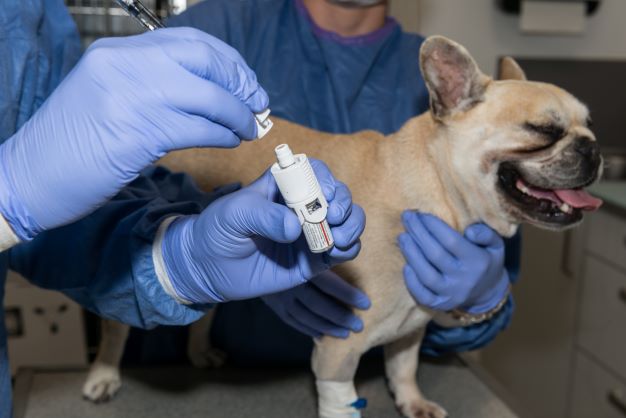This brief article describes ways in which Versant Medical Physics and Radiation Safety supports veterinarians and laboratory scientists who work with animal patients and laboratory research animals. Dosimetry is the science of measuring radiation and determining the amount of radiation energy that is imparted to living tissues. Radiation dosimetry is helpful in many medical science applications, such as correlating dose with biological effect, diagnosing disease, and planning radiation therapy for cancer treatment.
Nuclear medicine is a fundamental medical specialty in radiology. In nuclear medicine, radiologists administer radioactive drug products to patients to diagnose and treat many different health conditions.
In the healthcare setting, radiation dosimetry helps doctors to better understand the complex relationships between the amount (activity) of a radiopharmaceutical administered and the drug product’s biodistribution and metabolism in the body–such as its localization, retention, and clearance patterns.
The biological behavior of the pharmaceutical inside the patient can be imaged using modern radiation-detection systems in two or three dimensions. The localized uptake of a radiopharmaceutical can indicate the function of organs, such as the heart, brain, liver, and kidneys (among others), and is particularly helpful in diagnosing cancer.
Radiation dosimetry provides the fundamental quantities used for radiation protection, risk assessment, and treatment planning.
Animal subjects and humans are similar biologically in many ways. Therefore, different animal species may also be diagnosed and treated using the same or similar radiopharmaceuticals given to humans. And laboratory animals help researchers develop and test new drug products to ensure their safety and efficacy. Internal radiation dosimetry for animals has therefore become an important subspecialty of nuclear medicine physics.
Fundamental principles
Basic physics methods for internal radiation dosimetry are similar for animal and human models. Differences include the size and geometry of source-target organ pairs. Source organs are the internal organs for which images have been acquired or for which measurements have been made to determine the specific uptake, retention, and clearance patterns for the radioisotope.
Target organs are the organs and tissues for which radiation doses are calculated. Recognizing the important size and metabolic rate differences among species, care must be taken by the nuclear medicine physicist to use correct calculation methods and the most relevant animal model.
Common animal species
In veterinary medicine, pet owners take their animals to clinics for evaluation and treatment of cancer, hyperthyroidism, and organ function. The most common species include dogs, cats, and horses. In laboratory research, scientists use normal and immunodeficient mice, rats, rabbits, and sometimes dogs, monkeys, and miniature pigs.

Most biomedical research involves mice because they are less expensive, more easily housed and fed, and more efficiently bred for certain desirable genetic or mutational characteristics. Experiments with mice can also be accomplished in shorter time periods and with greater numbers for statistical purposes than other animal species.
Optimizing radiation dose for diagnostics or cancer treatment
Radiation dosimetry guides the veterinarian when choosing the right amount of radiopharmaceutical for a specific purpose. Every radionuclide in the chart has unique energy emission characteristics, half-life, and chemistry for applications as drug products. Some radionuclides are good for imaging in the clinic, whereas others are more appropriate for therapeutics. For each type, dosimetry is important to determine the characteristics that provide either the most useful images or the most effective treatment.
In both diagnostic imaging and cancer treatment, which are subspecialties of nuclear medicine physics, a balance must be achieved between administering too much or too little. Too little diagnostic drug renders poor images, too much radionuclide results in poorer quality images, making medical interpretation all the more difficult. In cancer therapy, too little radionuclide may result in an ineffective therapy, whereas too much radionuclide may result in undesirable normal tissue toxicity.

Excessive radionuclide handling in the pharmacy or clinic may also present an unnecessary radiation hazard to staff—or to pet owners, post-treatment. Radiation dose assessment helps veterinarians and research teams investigate the safest and most effective use of radiopharmaceuticals for the diagnosis and treatment of many disorders in animal subjects.
Dosimetry methods and models
For more than 50 years, specific methods and models for internal organ and tumor dose assessment have been developed by the special committee on Medical Internal Radiation Dose (MIRD) of the Society of Nuclear Medicine and Medical Imaging as a technical resource for both physicians and physicists. The virtue of the MIRD approach is that it systematically reduces complex dosimetric analyses to methods that are relatively simple to use, including software tools for experimental and clinical use.
Radiopharmaceutical dosimetry accounts for both physical and biological factors. Methods for internal radiation dosimetry tackle the challenge of assessing dose for many different radionuclides—each with its unique radiological characteristics and chemical properties as labeled compounds—in the highly diverse biological environment represented by the living body, internal organs, tissues, fluid compartments, and microscopic cells. Methods developed for human internal dosimetry are readily adaptable to animal subjects–taking into account the differences in size, geometry, and metabolic rates.
Why Versant Physics provides medical internal radiation dosimetry for animal subjects
Dogs, cats, and horses can be diagnosed and treated with radiopharmaceuticals for cancer and some non-malignant growths or overactive thyroid glands. Pet owners have often developed close family-like relationships with their pets, and veterinary care can be essential for preserving the animal’s health and well-being.
The development and testing of new radiopharmaceuticals usually begin with laboratory studies in mice. When promising results are achieved in mice, the investigators may advance to dog studies or even early clinical trials in humans, if approved by the Food and Drug Administration (FDA).
The FDA expects reliable and trustworthy radiation dosimetry for safety and efficacy evaluations. These assessments may rely on careful extrapolation of dosimetry results in animals to humans before drug trials can be approved for human patients.
Learn more about Dr. Darrell Fisher and his work in nuclear medicine physics here. Contact Versant Physics for your clinical dosimetry and personnel dosimetry needs.

